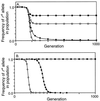The hotspot conversion paradox and the evolution of meiotic recombination
- PMID: 9223314
- PMCID: PMC21556
- DOI: 10.1073/pnas.94.15.8058
The hotspot conversion paradox and the evolution of meiotic recombination
Abstract
Studies of meiotic recombination have revealed an evolutionary paradox. Molecular and genetic analysis has shown that crossing over initiates at specific sites called hotspots, by a recombinational-repair mechanism in which the initiating hotspot is replaced by a copy of its homolog. We have used computer simulations of large populations to show that this mechanism causes active hotspot alleles to be rapidly replaced by inactive alleles, which arise by rare mutation and increase by recombination-associated conversion. Additional simulations solidified the paradox by showing that the known benefits of recombination appear inadequate to maintain its mechanism. Neither the benefits of accurate segregation nor those of recombining flanking genes were sufficient to preserve active alleles in the face of conversion. A partial resolution to this paradox was obtained by introducing into the model an additional, nonmeiotic function for the sites that initiate recombination, consistent with the observed association of hotspots with functional sites in chromatin. Provided selection for this function was sufficiently strong, active hotspots were able to persist in spite of frequent conversion to inactive alleles. However, this explanation is unsatisfactory for two reasons. First, it is unlikely to apply to obligately sexual species, because observed crossover frequencies imply maintenance of many hotspots per genome, and the viability selection needed to preserve these would drive the species to extinction. Second, it fails to explain why such a genetically costly mechanism of recombination has been maintained over evolutionary time. Thus the paradox persists and is likely to be resolved only by significant changes to the commonly accepted mechanism of crossing over.
Figures






Similar articles
-
Persistence and loss of meiotic recombination hotspots.Genetics. 2005 Apr;169(4):2319-33. doi: 10.1534/genetics.104.034363. Epub 2005 Jan 31. Genetics. 2005. PMID: 15687277 Free PMC article.
-
The Red Queen theory of recombination hotspots.J Evol Biol. 2011 Mar;24(3):541-53. doi: 10.1111/j.1420-9101.2010.02187.x. Epub 2010 Dec 16. J Evol Biol. 2011. PMID: 21159001
-
PRDM9 and the evolution of recombination hotspots.Theor Popul Biol. 2019 Apr;126:19-32. doi: 10.1016/j.tpb.2018.12.005. Epub 2019 Jan 17. Theor Popul Biol. 2019. PMID: 30660607
-
Meiotic recombination hotspots: shaping the genome and insights into hypervariable minisatellite DNA change.Curr Top Dev Biol. 1998;37:37-75. doi: 10.1016/s0070-2153(08)60171-4. Curr Top Dev Biol. 1998. PMID: 9352183 Free PMC article. Review.
-
Meiotic recombination hotspots in plants.Biochem Soc Trans. 2006 Aug;34(Pt 4):531-4. doi: 10.1042/BST0340531. Biochem Soc Trans. 2006. PMID: 16856852 Review.
Cited by
-
High-resolution sperm typing of meiotic recombination in the mouse MHC Ebeta gene.EMBO J. 2003 Mar 17;22(6):1389-97. doi: 10.1093/emboj/cdg136. EMBO J. 2003. PMID: 12628931 Free PMC article.
-
PRDM9, a driver of the genetic map.PLoS Genet. 2018 Aug 30;14(8):e1007479. doi: 10.1371/journal.pgen.1007479. eCollection 2018 Aug. PLoS Genet. 2018. PMID: 30161134 Free PMC article. Review.
-
Diversity of Prdm9 zinc finger array in wild mice unravels new facets of the evolutionary turnover of this coding minisatellite.PLoS One. 2014 Jan 13;9(1):e85021. doi: 10.1371/journal.pone.0085021. eCollection 2014. PLoS One. 2014. PMID: 24454780 Free PMC article.
-
DNA sequence-mediated, evolutionarily rapid redistribution of meiotic recombination hotspots.Genetics. 2011 Nov;189(3):685-94. doi: 10.1534/genetics.111.134130. Genetics. 2011. PMID: 22084420 Free PMC article.
-
Extensive and biased intergenomic nonreciprocal DNA exchanges shaped a nascent polyploid genome, Gossypium (cotton).Genetics. 2014 Aug;197(4):1153-63. doi: 10.1534/genetics.114.166124. Epub 2014 Jun 6. Genetics. 2014. PMID: 24907262 Free PMC article.
References
Publication types
MeSH terms
LinkOut - more resources
Full Text Sources

